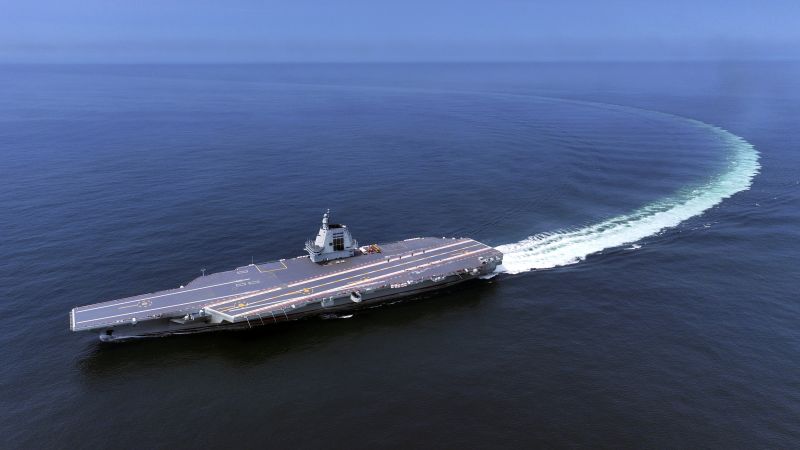Copyright Cable News Network

China’s latest and most capable aircraft carrier has officially entered service, a significant step forward for Beijing as it seeks to catch up with the United States on naval supremacy. Chinese leader Xi Jinping presided over the ceremony and inspected the ship during a commissioning ceremony at a military port in Sanya on Hainan island earlier this week, China’s state broadcaster CCTV reported on Friday. The Fujian is China’s third and most advanced aircraft carrier, featuring an electromagnetic catapult that can launch three aircraft types, according to Chinese state media. The new tech, known as EMALS, allows planes to take off with heavier weapon and fuel loads, so they can strike enemy targets at greater distances. The only other aircraft carrier in the world that has the EMALS system is the US Navy’s newest carrier, the USS Gerald R Ford, which was certified for flight deck operations using the EMALS system in the spring of 2022. Yet despite these advances, two former US carrier officers told CNN last month that the Fujian’s air operations may still run at only about 60% the rate of a 50-year-old US Navy carrier. The US Navy’s 10 older carriers, the Nimitz class, rely on steam-powered catapults to launch aircraft. However, none of China’s aircraft carriers are nuclear powered like all the US carriers. Nuclear power gives the US carriers the ability to remain at sea for as long as crew provisions last. The Fujian is powered by conventional fuel, meaning it must either make a port call or be met by a tanker at sea to refuel. Naval build-up China has been building the world’s largest navy, launching high-tech warships at a frenetic pace under Xi’s leadership, putting pressure on the United States and its Pacific allies to keep up. In terms of sheer number of ships, Beijing’s navy is now bigger than Washington’s and Chinese shipyards can churn out new builds at a far higher rate. But the US maintains a significant technological advantage and can field far more aircraft carriers. Nonetheless the Fujian’s official commissioning represents a milestone for China’s navy. Displacing 80,000 tons, it is the closest thing afloat to the US Navy’s 97,000-ton Nimitz-class carriers. And China is building another carrier, for now known as the Type 004, which is expected to not only employ EMALS technology, but also – unlike Fujian but like the USS Ford – be nuclear-powered. The Fujian’s flight deck is China’s first to forgo the ski jump-style ramp used by its smaller existing carriers, Liaoning and Shandong, to get aircraft airborne under their own power. Chinese state media and military expert Zhang Junshe praised the vessel as proof of China’s emergence as a major aircraft carrier power, following launch trials. However, concerns about its air operations emerged after a Chinese military blogger commented on a video about the Chinese military on state-run CCTV, featuring the Fujian. The blogger, writing on the military commentary blog Haishixianfeng, said: “Both of the catapults are situated close to the middle-front section of the landing area, so either the J-15 or J-35 (China’s two carrier-based fighter jets) would roll over the catapults when they land, temporarily preventing them from being used for launch operations and thus affecting the takeoff efficiency of the fighter jets.” The comments were picked up by South Korea’s Chosun Ilbo newspaper, and CNN asked the two former US Navy officers to review that report and the video. Carl Schuster, a former US Navy captain who served on two US aircraft carriers, and retired Lt. Cmdr. Keith Stewart, a former US naval aviator, also commented on the Fujian’s deck layout. Schuster noted that the landing area is angled only 6 degrees off center—less than the Nimitz-class US carriers—limiting space between the landing strip and catapults. Additionally, its longer landing area extends too close to the bow, he suggested, further restricting aircraft movement. Both Schuster and Stewart noted that the forward catapults seem to be longer on the Fujian than the Nimitz, meaning aircraft would be at risk of flight deck collisions as they move between the elevators and the hangar deck. To mitigate this, they said, the only option is to reduce the pace of flight deck operations.



